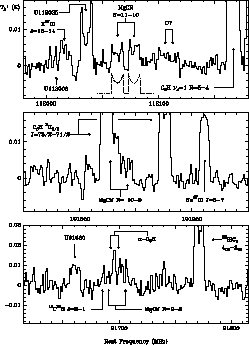



Next: New Preprints
Up: Scientific Results
Previous: The jet-driven molecular
L.M. Ziurys  , A.J. Apponi
, A.J. Apponi  , M. Guélin
, M. Guélin  ,
J. Cernicharo
,
J. Cernicharo 
 Department of Chemistry, Arozona State University, Tempe, AZ 85287-1604, USA
Department of Chemistry, Arozona State University, Tempe, AZ 85287-1604, USA
 IRAM, 300 rue de la Piscine, 38406 St. Martin d'Hères, France
IRAM, 300 rue de la Piscine, 38406 St. Martin d'Hères, France
 Centro Astronómico de Yebes, I.G.N., 19080 Guadalajara, Spain
Centro Astronómico de Yebes, I.G.N., 19080 Guadalajara, Spain
Abstract: A new
metal-containing molecule, MgCN, has been detected towards the
late-type star IRC+10216, using the NRAO 12m and IRAM 30m telescopes
(Fig. 3). The  ,
and
,
and  transitions of this species, which has a
transitions of this species, which has a
 ground state, have been observed in the outer envelope of
this objects at 3mm. For the
ground state, have been observed in the outer envelope of
this objects at 3mm. For the  transition, the two
spin-rotation components are clearly resolved and conclusively
identify this new radical. These measurements imply a column density
for MgCN of
transition, the two
spin-rotation components are clearly resolved and conclusively
identify this new radical. These measurements imply a column density
for MgCN of  cm
cm in the outer shell,
which corresponds to a
fractional abundance of
in the outer shell,
which corresponds to a
fractional abundance of  . This molecule,
the metastable
isomer of MgNC, is the third metal-bearing species thus far identified
in the outer shell of IRC+10216, and its detection implies a ratio of
MgNC/MgCN
. This molecule,
the metastable
isomer of MgNC, is the third metal-bearing species thus far identified
in the outer shell of IRC+10216, and its detection implies a ratio of
MgNC/MgCN  . MgCN may be formed through a reaction scheme involving
magnesium and HNC or CN, both prominent outer shell molecules, or
through synthesis or grains.
. MgCN may be formed through a reaction scheme involving
magnesium and HNC or CN, both prominent outer shell molecules, or
through synthesis or grains.

Figure 3: Spectrum of the  ,
,
 , and
, and  transitions of
MgCN obtained with
the IRAM 30m telescope towards IRC+10216 at 112, 102, and 92 GHz,
using 1 MHz resolution. Assumed LSR velocity is -26.4 km/s. The
transitions of
MgCN obtained with
the IRAM 30m telescope towards IRC+10216 at 112, 102, and 92 GHz,
using 1 MHz resolution. Assumed LSR velocity is -26.4 km/s. The  spin-doublets are clearly resolved in these data (see
the expected doublet profile drawn below the spectrum in dotted
line). Again, one doublet of the
spin-doublets are clearly resolved in these data (see
the expected doublet profile drawn below the spectrum in dotted
line). Again, one doublet of the  transition is partially
obscured by C
transition is partially
obscured by C H. For the
H. For the  lines, the center of the
two doublets is contaminated by c-C
lines, the center of the
two doublets is contaminated by c-C H, but MgCN emission is
distinctly present.
H, but MgCN emission is
distinctly present.
Robert Lucas
Fri Mar 17 14:32:02 MET 1995

 ,
,
 , and
, and  transitions of
MgCN obtained with
the IRAM 30m telescope towards IRC+10216 at 112, 102, and 92 GHz,
using 1 MHz resolution. Assumed LSR velocity is -26.4 km/s. The
transitions of
MgCN obtained with
the IRAM 30m telescope towards IRC+10216 at 112, 102, and 92 GHz,
using 1 MHz resolution. Assumed LSR velocity is -26.4 km/s. The  spin-doublets are clearly resolved in these data (see
the expected doublet profile drawn below the spectrum in dotted
line). Again, one doublet of the
spin-doublets are clearly resolved in these data (see
the expected doublet profile drawn below the spectrum in dotted
line). Again, one doublet of the  transition is partially
obscured by C
transition is partially
obscured by C H. For the
H. For the  lines, the center of the
two doublets is contaminated by c-C
lines, the center of the
two doublets is contaminated by c-C H, but MgCN emission is
distinctly present.
H, but MgCN emission is
distinctly present.



 , A.J. Apponi
, A.J. Apponi  , M. Guélin
, M. Guélin  ,
J. Cernicharo
,
J. Cernicharo 
 Department of Chemistry, Arozona State University, Tempe, AZ 85287-1604, USA
Department of Chemistry, Arozona State University, Tempe, AZ 85287-1604, USA IRAM, 300 rue de la Piscine, 38406 St. Martin d'Hères, France
IRAM, 300 rue de la Piscine, 38406 St. Martin d'Hères, France Centro Astronómico de Yebes, I.G.N., 19080 Guadalajara, Spain
Centro Astronómico de Yebes, I.G.N., 19080 Guadalajara, Spain  ,
and
,
and  transitions of this species, which has a
transitions of this species, which has a
 ground state, have been observed in the outer envelope of
this objects at 3mm. For the
ground state, have been observed in the outer envelope of
this objects at 3mm. For the  transition, the two
spin-rotation components are clearly resolved and conclusively
identify this new radical. These measurements imply a column density
for MgCN of
transition, the two
spin-rotation components are clearly resolved and conclusively
identify this new radical. These measurements imply a column density
for MgCN of  cm
cm in the outer shell,
which corresponds to a
fractional abundance of
in the outer shell,
which corresponds to a
fractional abundance of  . This molecule,
the metastable
isomer of MgNC, is the third metal-bearing species thus far identified
in the outer shell of IRC+10216, and its detection implies a ratio of
MgNC/MgCN
. This molecule,
the metastable
isomer of MgNC, is the third metal-bearing species thus far identified
in the outer shell of IRC+10216, and its detection implies a ratio of
MgNC/MgCN  . MgCN may be formed through a reaction scheme involving
magnesium and HNC or CN, both prominent outer shell molecules, or
through synthesis or grains.
. MgCN may be formed through a reaction scheme involving
magnesium and HNC or CN, both prominent outer shell molecules, or
through synthesis or grains.